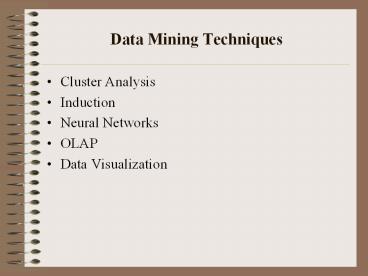Data Mining Techniques - PowerPoint PPT Presentation
Title:
Data Mining Techniques
Description:
Data Analysis and Modeling, Data Fusion and Mining, Knowledge Discovery ... Intelligent Data Mining Tools. Automate the process of discovering patterns ... – PowerPoint PPT presentation
Number of Views:1085
Avg rating:3.0/5.0
Title: Data Mining Techniques
1
Data Mining Techniques
- Cluster Analysis
- Induction
- Neural Networks
- OLAP
- Data Visualization
2
Association Rule
- An association rule is a rule, which implies
certain association relationships among a set of
objects (such as occur together or one implies
the other) in a database. - Given a set of transactions, where each
transaction is a set of literals (called items),
an association rule is an expression of the form
X Y, where X and Y are sets of items. - The intuitive meaning of such a rule is that
transactions of the database, which contain X,
tend to contain Y.
3
Support
- The support of an item set S is the percentage of
those transactions in T which contain S. - If U is the set of all transactions that contain
all items in S, then support(S) (U / T)
100, where U and T are the number of
elements in U and T, respectively.
4
Confidence
- Confidence of a candidate rule X Y is calculated
as support(XY) / support(X). - The confidence of rule X Y represents the
percentage of transactions containing items in X
that also contain items in Y
5
Example Association Rule
- In a store we might have Icheese,ham,bread,butte
r,salt,coke - A transaction could look like tbread,butter
for a customer who bought cheese and coke. - An association rule would be like the following
breadgtbutter with support 60 and confidence 80
also bought butter.
6
Apriori Algorithm
- Find all combinations of items that have
transaction support above minimum support. Call
those combinations frequent itemsets. - Use the frequent itemsets to generate the desired
rules.
7
Apriori Algorithm(contd)
- Pass 1
- Generate the candidate itemsets in C1
- Save the frequent itemsets in L1
- Pass k
- Generate the candidate itemsets in Ck from the
frequent itemsets in Lk-1 - Join Lk-1 with Lk-1, as follows insert into Ck
select p.item1, q.item1, . . . , p.itemk-1,
q.itemk-1 from Lk-1 p, Lk-1q where p.item1
q.item1, . . . , p.itemk-1 lt q.itemk-1
8
Apriori Algorithm(contd)
- 3. Generate all (k-1)-subsets from the candidate
itemsets in Ck - 4. Prune all candidate itemsets from Ck where
some (k-1)-subset of the candidate itemset is not
in the frequent itemset Lk-1 - 2. Scan the transaction database to determine the
support for each candidate itemset in Ck - 3. Save the frequent itemsets in Lk
9
Smart Web Search Agents
- Data Search Engines gtgt Information Search Agents
- - Traditional searching on the Web is done using
one of the following three - - Directories (Yahoo, Lycos, etc)
- - Search Engines (AltaVista, NorthernLight,
etc) - - Metasearch Engines (MetaCrawler, SavvySearch,
AskJeeves, etc) - All of these involve keyword searches
Drawback not easily personalized, - too many results (although many give
relevancy factors)
10
- - local cache databases (containing frequently
asked queries/results possibly updated
periodically - nightly!) - - local cache information base (containing mined
information and discovered knowledge for
efficient personal use) - - domain-based agents (e.g. Job Search
Sports-NBA Stats, Bibliography-Digital Libraries)
11
Intelligent Tools for E-Business
- Computational Intelligence, Neural Networks,
Fuzzy Logic, Genetic Algorithms, Hybrid Systems - Learning Algorithms, Heuristic Searching
- Data Analysis and Modeling, Data Fusion and
Mining, Knowledge Discovery - Prediction Time Series Analysis
- Information Retrieval, Intelligent User Interface
- Intelligent Agents, Distributed IA and
Multi-Agents, Cooperative Knowledge-based Systems
12
Enhancing E-Business Process Through Data Mining
- Traditional Data Mining Tools
- Simple query and reporting
- Visualization driven data exploration tools, OLAP
- Discovery process is user driven
- Quality of discovered knowledge
- Having right data
- Having appropriate data mining tools!!!
13
Intelligent Data Mining Tools
- Automate the process of discovering
patterns/knowledge in data - Require hypothesis, exploration
- Derive business knowledge (patterns) from data
- Combine business knowledge of users with results
of discovery algorithms
14
Intelligent Information Agents
- The Data Mining Problem
- Clustering/ Classification
- Association
- Sequencing
- Viewed as an Optimization Problem
- Tools Genetic Algorithms
15
Fuzzy Rules Discovering
- Rules discovering The discovery of associations
between business events, i.e. which items are
purchased together - In order to do flexible querying and intelligent
searching, fuzzy query is developed to uncover
potential valuable knowledge - Fuzzy Query uses fuzzy terms like tall, small,
and near to define linguistic concepts and
formulate a query - Automated search for fuzzy Rules is carried out
by the discovery of fuzzy clusters or
segmentation in data































